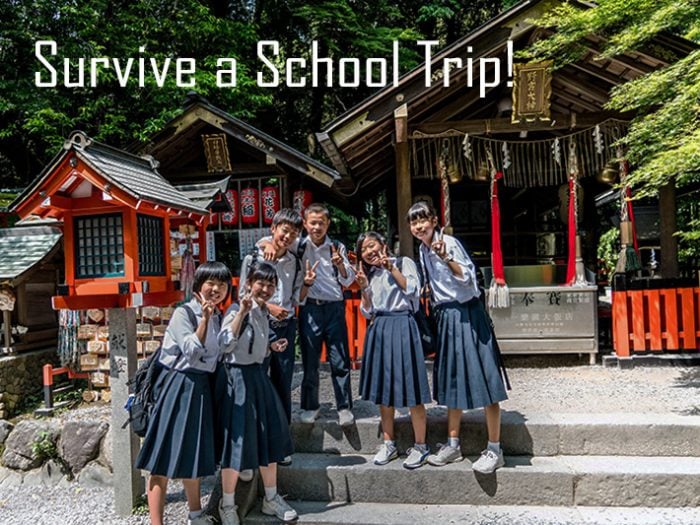
“How do I keep an eye on ten children at a time?”
“I struggle to navigate through trains on my own – let alone with kids!”
“They don’t understand my instructions, and I can’t speak Japanese, how do I keep them safe?”
These are common worries that you may have when taking students on a school trip. I know I had them when my first trip was looming, but there is no need to worry, they often go smoother than you think. School trips can be a great way to get to know your students outside of the classroom, and while they can also leave new teachers with feelings of dread and despair, they can also be really fun!
What to expect:
The first important thing to note about these trips is that you are not alone. Literally, you are not expected to take care of a group of children by yourself. In my experience, a Japanese teacher is always paired with a foreign teacher and they are assigned a group of 10-15 children. This was one of the first things to put me at ease when preparing for my first trip, I thought that at least if the children don’t understand me, then the Japanese teacher can translate. It’s true that the Japanese teacher can help with with the language barrier and any misbehaving children you might have but they often will expect you to take the lead on everything. I’m working at an English conversation school after all and they are selling the immersive English experience to the parents. This means that you have to lead any activities planned but this shouldn’t fill you with too much panic, just have confidence and teach like you do in the classroom. I remember being really nervous before a trip as I was told I had to lead one of the planned activities. I found that it wasn’t doing this in front of a group of children that was nerve wracking, but rather that there were other teachers around following my lead. Just remember to have fun, that’s what the students are there for.
School trips are also a great way to get to see places in Japan which you might not have thought to see be yourself. Some examples are The Ghibli museum, Enoshima aquarium and The Cup Noodle museum. You can also expect to go to many different parks especially when there is a seasonal flower festival, and don’t forget you can go for free and get paid for your trouble. These trips are very much for staff to enjoy as well as the children. Take the opportunity to feel like a child yourself again for the day, all while keeping a responsible mind. These trips can often take place on a Saturday or Sunday, therefore the places you will visit are likely to be very busy so remember to do regular head counts often.
You might be wondering how you can incorporate English into these trips when you are visiting places in Japan, which all be saturated with Japanese. This is where those activities previously mentioned come into play. You could teach them the English Ghibli movie names, various cup noodle toppings and marine animals. It depends on your school but either you or a Japanese staff member might create a little sticker book for them or find things and complete. The best way though is just to talk to your students, find out what their favourite movie, animal or food might be. Seeing how your students interact outside the classroom can give you valuable information to use in the classroom, you might find that even your most difficult students can open up or behave better in a different setting.
How to prepare:
Now that you have an idea of what to expect, here’s how you can prepare yourself.
Before – What to bring
It may be common sense, but my best advice would be to check the weather. If you’re going on a hot day, then bring the essentials – suncream, sunglasses, light clothes, cooling spray, cool packs, any other cooling product you can find in Daiso. Summer in Japan is hot and uncomfortable, increase that feeling by walking around somewhere with a group of children for 8 hours and you will be a puddle of sweat by the end of the day. So be prepared, and pack any product that helps you to keep cool. My top tip for summer trips is to freeze a bottle of water, this will act as an ice pack and a cool drink once you finish your others or they turn warm. On the other hand, if you are going in the cooler months or rainy season then act accordingly. An umbrella or rain jacket are must haves and an extra pair of socks. There is nothing worse than walking around with wet feet.
Aside from seasonal items, bring your lunch and wear comfortable shoes. Also bring candy if your school allows it, enough for your group of students. Japanese children kindly share out their candy to everyone at lunch time and it’s nice to give them some back in return, you can also snack on it throughout the day for that much needed energy boost.
During – What to do
Now you have packed everything but the kitchen sink and you feel prepared, it is now time to embark on your trip. Like I mentioned before, these trips are about fun while staying safe. If you have younger children in your group try and get them to hold your hand or the hand of an older student, pair the students up when walking or give them a number to remember and do regular role calls. These are all effective ways to ensure safety in your group. If you are feeling a bit overwhelmed then follow the lead of the Japanese teacher or the more experienced foreign teachers but try and stay relaxed, it will be a very long day if you spend it constantly stressed. Please just have fun, play games and build a rapport with your students. Enjoy where your going and it will be over before you know it.
After – Relax
Phew, you made it! And you actually managed to have some fun along the way. All that’s left is to return the students to their parents, take some photos and chat to the parents. This is a good way to get to know them and you’ll find a lot of them speak some English. After all, the students have left, it’s time to thank your colleagues for their hard work, head home, order a takeaway and sleep.
While these excursions can take you out of your comfort zone of the classroom they are actually more fun than stressful. Hopefully, now that you know what to expect there will be less before-trip anxiety and more anticipation. It can be a tiring day but one hopefully full of fun memories you can keep even after you’ve left Japan.













